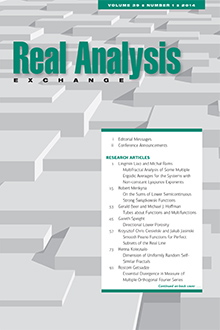Abstract
Call a sum of exponentials of the form $f(x)=\exp\left( 2\pi iN_{1}x\right) +\exp\left( 2\pi iN_{2}x\right) +\cdot\cdot\cdot+\exp\left( 2\pi iN_{m}x\right) $, where the $N_{k}$ are distinct integers, an idempotent. We have $L^{p}$ interval concentration if there is a positive constant $a$, depending only on $p$, such that for each interval $I\subset\left[ 0,1\right] $ there is an idempotent $f$ so that $\int _{I}\left\vert f\left( x\right) \right\vert ^{p}dx\diagup\int_{0} ^{1}\left\vert f\left( x\right) \right\vert ^{p}dx>a$. We will explain how to produce such concentration for each $p>0$. The origin of this question and the history of the development of its solution will be surveyed.
Citation
J. Marshall Ash. "How to Concentrate Idempotents." Real Anal. Exchange 35 (1) 1 - 20, 2009/2010.
Information





